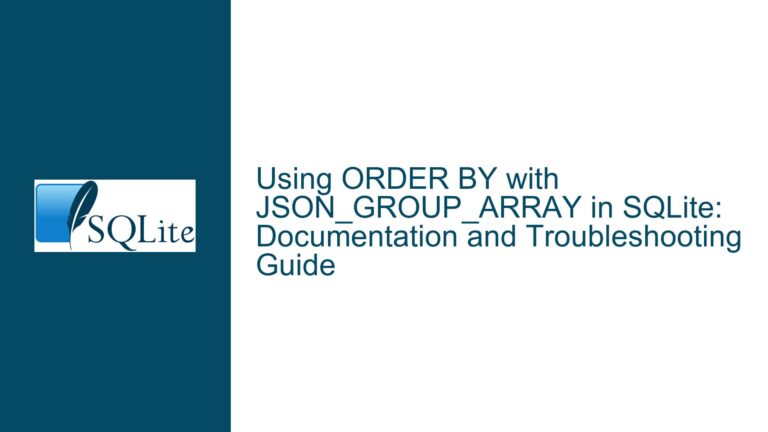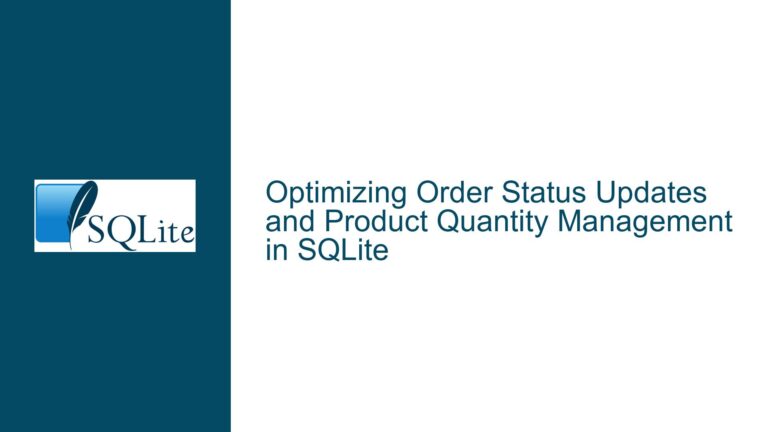View Column Affinity Ambiguity in SQLite Compound SELECT Queries
Ambiguous Column Affinity in Compound View Definitions
The core technical challenge arises when combining compound SELECT operations (EXCEPT/UNION/INTERSECT) with explicit view column definitions, creating non-deterministic type affinity behavior. This manifests as unexpected empty result sets when filtering through views compared to equivalent direct queries, due to SQLite’s dynamic type system interacting with view column declarations.
The canonical example demonstrates this through three critical observations:
- Direct execution of
SELECT c1 FROM t0 EXCEPT SELECT c0 FROM t0returns value 1 - Filtering through view
v0usingSELECT * FROM v0 WHERE (c0 NOT BETWEEN '-1' AND c0)yields empty results - The same filter condition applied directly to view’s underlying query returns expected results
This discrepancy stems from SQLite’s handling of column affinity in compound SELECT statements within explicitly defined views. When creating a view with CREATE VIEW v0(c0) AS ..., the declared column name "c0" establishes an affinity inheritance chain that conflicts with the underlying SELECT operations’ type resolution logic.
Key technical components involved:
- Type affinity propagation through compound operators
- View column declaration precedence over expression-derived affinity
- Implicit casting rules during comparison operations
- Query optimizer decisions based on static column metadata
The behavior became apparent after SQLite 3.9.0 (2015-10-14) with check-in d794b34da6f9c77d, which introduced explicit view column naming capabilities. Earlier versions prevented this specific conflict by not allowing manual column affinity declarations in view definitions.
Root Causes of Affinity Mismatch in UNION/EXCEPT Views
Three primary factors combine to create this subtle interaction:
1. Compound SELECT Affinity Resolution
SQLite determines column affinity for compound queries using the left-most component’s affinity when no explicit typing exists. For:
SELECT b FROM t0 EXCEPT SELECT a FROM t0
The result column inherits affinity from b in table t0. However, when wrapped in a view with explicit column naming:
CREATE VIEW v0(c) AS SELECT b FROM t0 EXCEPT SELECT a FROM t0
The view’s declared column "c" creates a new affinity context disconnected from the underlying query’s type derivation.
2. Affinity Precedence Hierarchy
SQLite applies the following priority when resolving column affinity:
- Explicit CAST expressions
- View column declarations
- Source table column affinities
- Expression-based affinity detection
This hierarchy causes the view’s manual column name declaration to override the natural affinity derived from the EXCEPT operation’s left-hand SELECT.
3. Comparison Operator Type Coercion
The BETWEEN operator follows strict type conversion rules:
Expression: c0 NOT BETWEEN '-1' AND c0
Performs comparisons using:
- Numeric affinity if any operand has INTEGER/REAL affinity
- TEXT affinity if all operands are TEXT/BLOB
- BLOB affinity as last resort
When view column affinity ambiguously resolves to BLOB (no declared type), the comparison converts ‘-1’ to BLOB, making numeric comparison impossible.
4. View Metadata Persistence
SQLite stores view column names and types in the sqlite_master table as static metadata. The query optimizer uses this persisted metadata rather than recalculating affinity from the view definition when optimizing WHERE clause processing.
Resolving Affinity Conflicts in SQLite View Queries
Diagnostic Procedure
- Identify Affinity Mismatches
SELECT typeof(c0), c0 FROM v0;
Compare with:
SELECT typeof(c0), c0 FROM (SELECT c1 FROM t0 EXCEPT SELECT c0 FROM t0);
A difference in typeof() output indicates view-mediated affinity change.
- Inspect View Declaration Impact
Create parallel views with and without explicit column typing:
CREATE VIEW v_typed(c INT) AS ...;
CREATE VIEW v_untyped(c) AS ...;
Execute identical queries against both to isolate declaration effects.
- Analyze Comparison Context
Use EXPLAIN to see type conversions:
EXPLAIN SELECT (c0 NOT BETWEEN '-1' AND c0) FROM v0;
Look for Affinity and Type flags in the opcode output.
Prevention Strategies
1. Explicit CAST in View Definitions
Force affinity at view creation:
CREATE VIEW v0(c0) AS
SELECT CAST(c1 AS INTEGER) FROM t0
EXCEPT
SELECT CAST(c0 AS INTEGER) FROM t0;
This ensures consistent numeric comparison context.
2. Type Annotation in View Column Declarations
Specify column types when creating views:
CREATE VIEW v0(c0 INTEGER) AS ...;
Overrides natural affinity derivation with explicit INTEGER affinity.
3. Subquery Wrapping Technique
Isolate compound operations in subqueries with typed aliases:
CREATE VIEW v0(c0) AS
SELECT * FROM (
SELECT c1 FROM t0 EXCEPT SELECT c0 FROM t0
) AS sub(c0 INTEGER);
4. Materialized View Pattern
For critical comparisons, use a temporary table:
CREATE TEMP TABLE tmp_v0 AS
SELECT c1 FROM t0 EXCEPT SELECT c0 FROM t0;
CREATE INDEX tmp_v0_c0 ON tmp_v0(c0);
Provides stable affinity through physical storage.
5. Expression Affinity Hinting
Use no-op expressions to suggest affinity:
CREATE VIEW v0(c0) AS
SELECT (c1 + 0) FROM t0 EXCEPT SELECT c0 FROM t0;
The + 0 suggests numeric context without changing values.
Corrective Measures for Existing Systems
1. Affinity-aware Query Rewriting
Original problem query:
SELECT * FROM v0 WHERE c0 NOT BETWEEN '-1' AND c0;
Rewrite using explicit casting:
SELECT * FROM v0
WHERE CAST(c0 AS REAL) NOT BETWEEN -1 AND CAST(c0 AS REAL);
2. View Definition Migration
For views created with ambiguous affinity:
ALTER VIEW v0(c0) RENAME TO v0_old; -- Not actual SQL, requires recreation
CREATE VIEW v0(c0 INTEGER) AS
SELECT c1 FROM t0 EXCEPT SELECT c0 FROM t0;
3. Comparison Context Normalization
Use JSON1 extension for strict type handling:
SELECT * FROM v0
WHERE json_extract('["'||c0||'"]', '$')
NOT BETWEEN '-1' AND json_extract('["'||c0||'"]', '$');
Deep Technical Workarounds
1. SQLITE_DBCONFIG_VIEW_AFFINITY Flag
Advanced users can compile SQLite with custom flags to:
- Make view column declarations inherit underlying expression affinity
- Disable view column type persistence
Requires source code modification insqlite3_db_confighandling.
2. Virtual Table Proxy
Create a virtual table wrapper for views:
CREATE VIRTUAL TABLE v0_proxy USING module(
(SELECT c1 FROM t0 EXCEPT SELECT c0 FROM t0)
);
Allows dynamic affinity resolution at query time.
3. Prepared Statement Affinity Locking
Force affinity during statement preparation:
PRAGMA encoding='UTF-8'; -- Affects BLOB affinity handling
Combine with:
PRAGMA application_id=0x1234; -- Controls internal type mapping
Best Practice Recommendations
- Compound View Typing Rules
- Always declare explicit column types in views wrapping compound SELECTs
- Prefer UNION ALL over UNION where possible to reduce affinity conflicts
- Avoid mixing TEXT and NUMERIC affinities in compound SELECT arms
- Comparison Safety Checklist
- Validate typeof() output for view columns used in WHERE clauses
- Use parameterized queries to avoid literal type ambiguity
- Implement regression tests comparing view vs direct query results
- Schema Migration Protocol
When altering tables underlying views with compound SELECTs: - Drop dependent views
- Modify table schema
- Recreate views with explicit column affinity declarations
- Run affinity consistency checks using:
SELECT name FROM pragma_table_xinfo('view_name') WHERE type = '';
This comprehensive approach addresses both immediate troubleshooting needs and long-term prevention strategies for SQLite view affinity conflicts, ensuring reliable query results across different interface points to complex view definitions.






